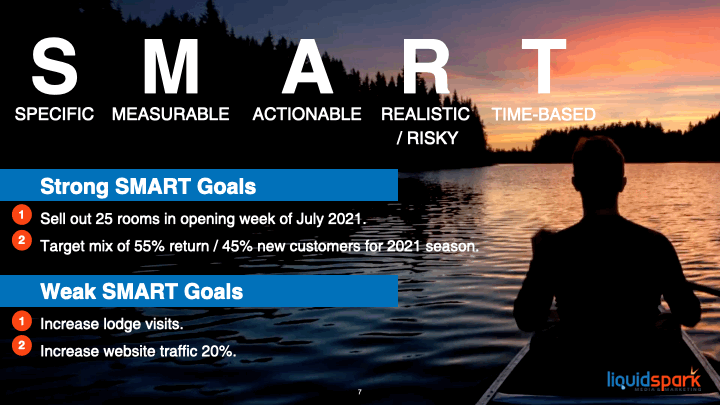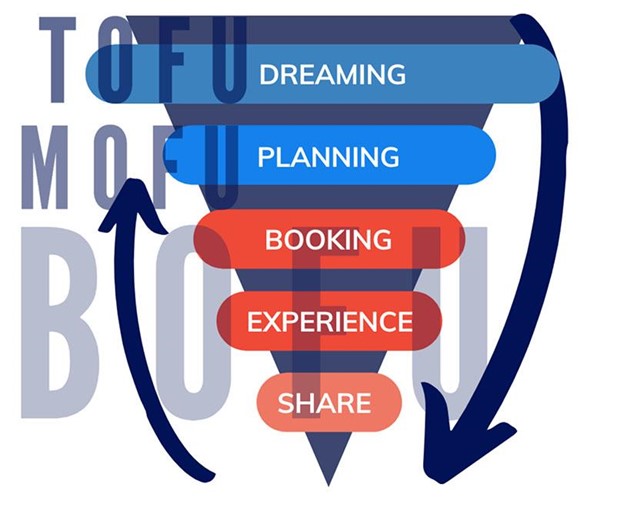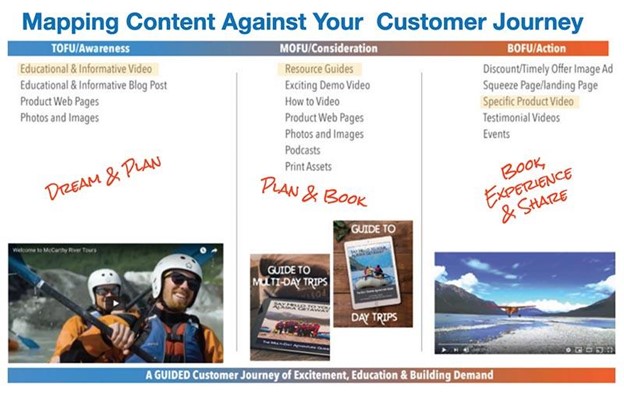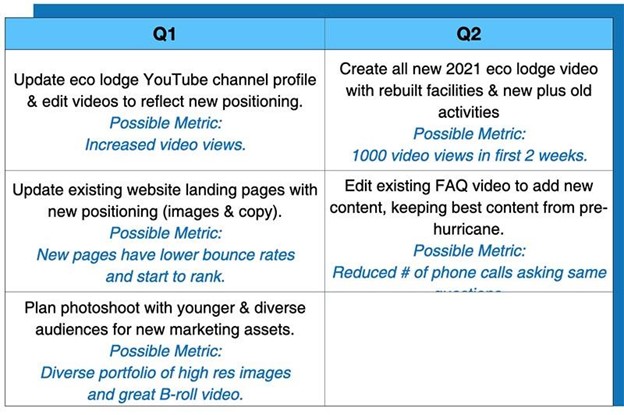A marketing roadmap is a foundational tool in your annual planning process; it identifies the best marketing initiatives for meeting your business goals, lays out those initiatives by quarter, and helps you understand:
-
What to do for your campaign execution;
-
What the best timing is for those campaigns, and;
-
How every piece of your marketing ecosystem fits together.
Below you will find the five steps in creating a strong quarterly marketing roadmap for your adventure brand. We link to an even more detailed how-to for all the worksheets, at the end of this post. List your own information for your business and be candid about where you have opportunities for improvement, and where you are hitting home runs now.
Step 1: Define Your Business Goals
Getting clear on what your business goals are for the next season is absolutely key. Being clear makes everything else downstream so much easier. During your annual planning period, you may have a lot of different business goals, and that’s fine. Your roadmap needs to reflect those goals that will, if achieved, make you feel like your upcoming season was a roaring success.
These typically fall under the following buckets:
-
Sales Goal
Example: Fill September specialty tours at 8 guests per program—targeting specific customer audiences.
-
Service Goal
Example: Run 5 Wounded Warrior Retreats in Quarter 1 & 2
-
Process Goal
Example: Publish 3 weekly social posts – across IG, FB, and GMB
-
Sustainability Goal
Example: Eliminate 100% of all single use plastic from the lodge by Quarter 4.
When writing your goals, we suggest following the time-honored acronym, SMART:
S: Smart
M: Measurable
A: Actionable
R: Realistic/Risky
T: Time-based

Strong SMART goals are very specific. And very clear, like: "Sell out 25 rooms in the opening week of July 2021.’
Weak SMART goals are not specific, and/or not clear, like: "Increase lodge visits.” [How do we decide what to do to impact such a general goal?
Step 2: Map Your Business Goals to Marketing Ideas & Add Timing
This is the fun part! What marketing initiatives could help you achieve your business goals? Create a big list, and don’t cull it down yet. Now is the time to gather your ideas on how you can best support the business goals you identified in step one.
As you think about these ideas, consider what the ideal timing is for them to best support your business. Think through what needs to happen, and in what order, to be able to launch your marketing campaigns. It might be one of the factors that helps you cull your list of initiatives down.
Make sure that you put your initiatives into your roadmap according to the quarterly timing.
Step 3. Connect Your Sales Funnel to Your Roadmap
So far, you have identified strong SMART business goals for your upcoming season and have mapped each of those goals to one or more marketing initiatives. Now, consider what content you have already that can be used or updated in your new marketing campaigns.
The way to do this is to critically review your existing sales funnel across your digital channels. This is your sales funnel, from your business viewpoint. From your customers’ viewpoint, this is what they “experience” as they travel through your digital marketing channels and learn about your adventure tourism offerings.

The traditional sales funnel has awareness building and prospecting at the top of the funnel, followed by educating and engaging visitors with useful information in the middle of the funnel. The bottom of the funnel contains those steps that will help your visitor make a booking decision. Each marketing initiative in your roadmap should address an information level in your sales funnel.
Step 4. Assess Your Customer Experience Journey & Add to Your Roadmap
Use our handy process worksheet Mapping Your Customer Experience Journey to uncover what current content you have at each level of your sales funnel/customer experience journey. As important, use this exercise to find the gaps of what content is missing for your customers and prospects.
Next, assess the content you have mapped in your worksheet against your roadmap’s new marketing initiatives.
Questions to Help Assess Your Content
-
What exists that you can leverage?
-
What’s missing?
-
What needs to be created?
-
Who can develop missing content?
-
When should content be ready?

Then map the results to your roadmap, by quarter.
Step 5: How Will You Measure Your Success?
Identify possible metrics for each initiative on your quarterly roadmap. This is an important step. Be clear on what you will measure. Be sure to celebrate each win, and/or adjust in real time, as the season progresses!

BONUS: Opt In for Detailed Action Plan Worksheets
Success will rest on your ability to implement your initiatives at the monthly and weekly level. We have developed worksheets that we use here at Liquid Spark, for our agency marketing and for our clients’ marketing, that will make this next leap much easier for you. Get the worksheets here.
Worksheets Include:
Strategy & Tactics Master Calendar
Organize your efforts all in one place by month, fed from your quarterly roadmap.
Email Marketing Calendar
Match your roadmap initiatives to your email marketing calendar and support your marketing year-round.
Social Media Organic Posting Calendar
Easily map out your monthly efforts and share your content with other team members.
Social Media Ad Campaign Tracking
Plan and track your campaign efforts—from run dates, budgets, audiences, waterfall funnels, and more.
Now is the time to finish out your initial 2021 marketing plans. 2021 will be a LOT better than 2020, and congratulations on your resilience through 2020. Here's to proactively setting up your business well, for your 2021 triple bottom line success!
About the Author:
Julie Thorner is the founder and president of Liquid Spark. She is a digital adventure parent nomad, strategic marketer, and geo-tourism advocate. Julie looks at the total business ecosystem with any marketing/business opportunity - with a focus on sustainability impacts and reciprocal benefit for people, place, and planet. She believes experiences in the outdoors are profoundly important and healthy for all people to enjoy - and they create opportunities for awareness and engagement to be part of solutions for our blue planet.